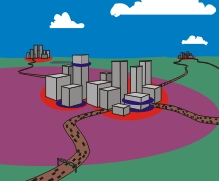Selection of Scenarios
Different wave propagation models (computational methods) exist to simulate the propagation environment. These models are necessary to determine propagation characteristics for any arbitrary configuration.
For the installation of mobile radio systems, wave propagation models are necessary to determine propagation characteristics for any arbitrary configuration. The predictions are required for a proper coverage planning, the determination of multipath effects as well as for interference and cell calculations, which are the basis for the high-level network planning process. In a GSM/DCS-system, this planning process includes for example the prediction of the received power to determine the parameter sets of the base stations. Since the introduction of wireless broadband services in third-generation systems (UMTS) or in Wireless Local Area Networks (W-LAN) the wideband properties (for example, delay spread, angular spread, and impulse response) of the mobile radio channel has become more and more important for the planning process. The environments where these systems are intended to be installed, are ranging from indoor up to large rural areas. Hence wave propagation prediction methods are required covering the whole range of macro-, micro- and pico-cells including indoor scenarios and situations in special environments like tunnels or along highways.

Figure 1. Example of a propagation environment scenario.
Rural and Suburban
In macro-cellular prediction models, forward propagation including multiple diffractions over terrain and buildings is applied. Scattering and reflection from hills, mountains, and buildings can generally be neglected because the base station is located above the surrounding obstacles to cover a large area. Possible applications are, for example, broadcasting transmitters or base stations in very low populated areas. The predictions are based on the knowledge of topography, land usage and in few models additionally building height information.
Urban
The design and implementation of personal communication systems require the prediction of wave propagation relating to signal-to-noise and signal-to-interference calculation in a cellular system. Small cell network configurations – especially micro and pico cell types – are of major interest in urban environments because of the increasing capacity demands. The commonly used criterion for the definition of a micro cell is related to the height of the base station antenna. For a typical micro cell, the base station antenna height is below the average rooftop level of the surrounding buildings or about the same height. Thus the resulting cell radius is in the range of 250-500m. A further characteristic is the low transmitting power. However, a prediction range up to several kilometers has to be regarded for inter-cellular interference calculations. A pico cell base station is usually installed inside a building providing coverage also outside around the building.
Indoor
Predicting the propagation characteristics between two antennas inside a building is important especially for the design of cordless telephones and Wireless Local Area Networks (WLAN). Also, the installation of cellular systems with indoor base stations involves the usage of indoor propagation models. The indoor propagation channel differs considerably from the outdoor one. The distance between transmitter and receiver is shorter due to high attenuation caused by internal walls and furniture and often also because of the lower transmitter power. The short distance implies a shorter delay of echoes and consequently lower delay spread. The temporal variations of the channel are slower compared to mobile antennas moving with a car. As it is the case in outdoor systems, there are several important propagation parameters to be predicted. The path loss and the statistical characteristics of the received signal envelope are most important for coverage planning applications. The wide-band and time variation characteristics are essential for evaluation of the system performance.